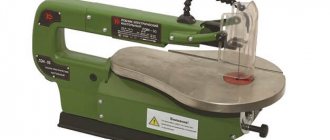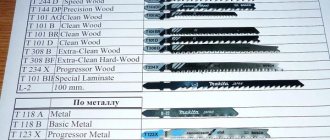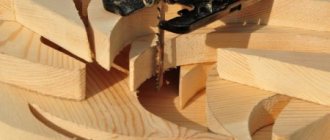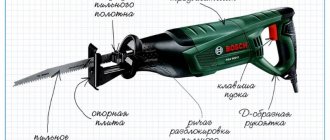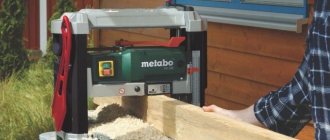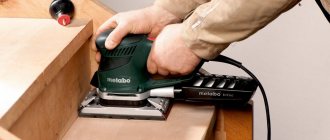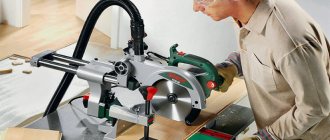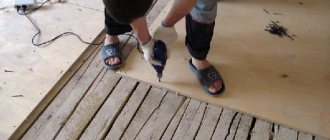Good afternoon, dear readers of the online store blog.
The saw blade is the most important working component in a jigsaw. How accurate, fast and high-quality the cut will be depends on it. Requirements for files for a manual jigsaw may be different, depending on what tasks they are selected for. For example, for crafts made from plywood, cutting laminate, metal, and complex shapes, a thin but slow cut is important; For working with wood or chipboard, you can use quick and rough. The job will be completed much faster if you choose the right saw blade. In this article, we will talk about the types and features of hand jigsaw files, how to choose them correctly, and also share several life hacks on what you can use to make files in your home workshop.
Shank type
How to choose the right saw blade for a jigsaw? Attention is drawn to the design of the shank. There are two main types:
- The T-shaped shank was developed by BOSCH. She was the first to develop and introduce it into mass production. The company is a leader among manufacturers of electrical equipment. Makita, Hitachi, Metabo and other manufacturers have also switched to this tip design. He occupies the highest level in the popularity ranking.
- The U-shaped shank is located in the next place in the rating. This is a representative of American manufacturers. Such designs are equipped with tools with screw and block clamps.
There are two more types of shank for rare Makita and Bosch electrical appliances. Now they are not produced, it is rare to find them. Each jigsaw has its own saw fixation, for which only one of the specified types of shank corresponds.
Blade length
To increase the quality of the work performed, the correct blade is selected that matches the material being processed. It has the following dimensions:
- The length is in the range of 40-250 mm. This saw can cut through thick objects. To work on thin material, it is better to use short ones, as they have less vibration.
- The width depends on the task at hand. To make straight cuts you will need a wide product. Narrow ones make it easier to change the direction of the cut.
- Thickness affects the quality of the cut. The greater the thickness, the less swaying occurs, and an accurate cut is obtained.
It is important to understand that a lot depends on the functionality of the power tool.
Hand jigsaws, files for jigsaws STAYER, BISON wholesale
Hand jigsaw in the SIBIN set
The SIBIN manual jigsaw is used for sawing thin-sheet materials: plywood, fiberboard, plastic panels. You can buy SIBIN manual jigsaws wholesale from us. | |||
| vendor code | Photo | Set contents | Price, rub |
| 15301-25 | Hand jigsaw 130 x 220 mm | 148 | Order |
Manual jigsaw STAYER “MASTER”
The STAYER hand jigsaw is used for cutting thin-sheet materials: plywood, fiberboard, plastic panels. You can wholesale STAYER hand jigsaws from us. | |||
| vendor code | Photo | Set contents | Price, rub |
| 1530-25_z01 | Hand jigsaw 130 x 250 mm | 218 | Order |
Hand jigsaw in the BISON set, MASTER series
The BISON manual jigsaw is used for sawing thin-sheet materials: plywood, fiberboard, plastic panels. You can wholesale BISON manual jigsaws from us. | |||
| vendor code | Photo | Set contents | Price, rub |
| 15310-H10 | 10 items: Hand jigsaw 130 x 260 mm; 6 wood paintings; Clamp; Tightening wrench; Guide stop | 1175 | Order |
Manual chrome-plated jigsaw “ZUBR” with a set of blades, “EXPERT” series
It is used for sawing thin-sheet materials: plywood, fiberboard, plastic panels. From us you can buy BISON manual jigsaws wholesale. | |||
| vendor code | Photo | Set contents | Price, rub |
| 15270-H7 | 7 items: Hand jigsaw 130 x 300 mm; 6 wood paintings | 1083 | Order |
| Files for a manual jigsaw SIBIN Files SIBIN are intended for use as replacement elements of a jigsaw for working with soft and hard wood. From us you can wholesale files for a manual jigsaw SIBIN. | ||||
| vendor code | Photo | Blade length, mm | Quantity, pcs | Price, rub |
| 1532-S-20 | 130 | 20 | 60 | Order |
Files for hand jigsaw STAYER
STAYER files are intended for use as replacement elements of a jigsaw (art. 1530-25) for working with soft and hard wood. You can buy files for a STAYER manual jigsaw wholesale from us. | |||||
| vendor code | Photo | Canvas number | Blade length, mm | Quantity, pcs. | Price, rub |
| 15321-S-10_z01 | №5 | 130 | 10 | 68,5 | Order |
| Files for a KRAFTOOL hand jigsaw KRAFTOOL files are designed for precise cutting of wood, plywood, and plastic in a straight line. From us you can wholesale saws for a KRAFTOOL hand jigsaw. | |||||
| vendor code | Photo | Canvas number | Blade length, mm | Quantity, pcs. | Price, rub |
| 15340-03 | №3 | 130 | 6 | 117 | Order |
| 15340-05 | №5 | 130 | 6 | 117 | Order |
| Files for a hand jigsaw KRAFTOOL KRAFTOOL files are used for cutting wood and drywall in different directions without changing the position of the workpiece. From us you can buy files for a KRAFTOOL hand jigsaw wholesale. | |||||
| vendor code | Photo | Canvas number | Blade length, mm | Quantity, pcs. | Price, rub |
| 15344-01 | №1 | 130 | 6 | 131 | Order |
| 15344-03 | №3 | 130 | 6 | 131 | Order |
| Files for manual jigsaws BISON ZUBR files are used for cutting wood and drywall in different directions without changing the position of the workpiece. From us you can wholesale files for a manual jigsaw BISON. | |||||
| vendor code | Photo | Canvas number | Blade length, mm | Quantity, pcs. | Price, rub/10 pcs. |
| 1532-10 | №5 | 130 | 10 | 124 | Order |
Set of files for hand jigsaw KRAFTOOL
A set of KRAFTOOL blades for a manual jigsaw is designed to perform precision work on sawing wood, plasterboard, plywood, plastic and soft metals. You can buy blades for a KRAFTOOL manual jigsaw wholesale from us. | |||||
| vendor code | Photo | Blade type | Article number of canvas | Quantity, pcs. | Price, rub |
| 15348-H20_z01 | For wood with double teeth (No. 3 and No. 5) | 15340-03 | 4 | 304 | Order |
| 15340-05 | 4 | ||||
| Spiral for wood (No. 1 and No. 3) | 15344-01 | 4 | |||
| 15344-03 | 4 | ||||
| For metal (No. 3 and No. 5) | №3 | 2 | |||
| №5 | 2 |
Source: https://ooo-pic.ru/lobziki_ruchnye
Geometric parameters of the cutting edge
When carefully examining the blades, we note that they have different geometric features of the sawing surface, differ in teeth and setting. Increasing the tooth set leads to an increase in the width of the sawing line. The work is done quickly, and its quality decreases. There are the following types of jigsaw attachments:
- Milled saws with classic layout. Each subsequent tooth bends in the opposite direction. This makes it possible to quickly saw material with low quality. Allows you to cut wood of different densities, plastic products and non-ferrous metals.
- With wavy wiring. Several teeth are smoothly bent in one direction, then a similar number is deflected in the opposite direction. The sawing edge has a wave shape. This is equipment for a jigsaw for chipboard, wood, plywood and plastic products, as well as non-ferrous metal.
- Ground saws with classic setting. The teeth are set apart and ground. This allows for high-quality cutting of wooden products, fiberboard and chipboard structures.
- With conical grinding. The teeth are not set apart, but they are ground. Designed for laminate, wood and polymer structures. Allows you to make thin, neat cuts.
Each of the above attachments has its own superiority for performing narrow tasks.
Features of files
Before you go to the store to buy a saw blade, you should familiarize yourself with the basic terminology that will help you make a better purchase.
Below, we will look at the most important and common features of the file, revealing the whole essence of this element. Any blade for a manual jigsaw that can be found on sale has a TPI parameter “Tooth Pro Inch”, which translated means “Number of teeth per inch (2.5 cm)”. The higher this indicator, the more accurate the cutting line will be, but the work process itself will become slower. Accordingly, the lower, the faster, but less accurately. The average TPI value is 15 teeth per inch or 6 per 1 cm.
Another important property of the saw blade is the tooth set. This indicator affects the movement of the saw in the material, preventing it from jamming and facilitating the cutting process. Not every specimen found on sale has this property, so you should pay attention to this in advance.
Metal cutting files
Do you need attachments for a jigsaw for metal? How to choose such a product? It is important to know that a jigsaw is difficult to cut metal products. It lacks the power of the electric motor and the speed of the web. Despite this, it is used in exceptional cases. To do this you need:
- have small teeth no more than 1 mm;
- divorce according to the wave principle.
It is advisable to have saws for steel, aluminum and other non-ferrous metals. This will allow the work to be completed as quickly as possible.
Make your own file
For a true craftsman with an equipped workshop, it is indecent to spend money on buying simple consumables that you can make yourself. In this case, the only thing that plays a role is the time that has to be paid in exchange for regular currency. Below, we have presented 2 options for creating a homemade file for a hand jigsaw. The video presented in each option will tell you about the process in more detail. We will describe the required tools and the main stages of production.
From a tin can
The following tutorial demonstrates the process of creating a spiral file from a regular tin can.
Such a product will help save your budget, since the average price of such paintings is 35 rubles per piece. What you will need:
- Metal tin can
- Metal scissors
- Clothespins (2 pcs)
- Pliers (2 pcs)
- Small anvil
- Hammer
Manufacturing process:
- Cut the tin can into long strips 1-2 mm wide.
- We clamp the resulting strips into clothespins from the edges and twist them into a spiral until a fine thread is obtained.
- We remove the clothespins and, holding the product in pliers on both sides, pull it out slightly.
- To give greater strength, place the future file on the anvil and lightly tap it until a flat shape is obtained.
- We cut off the excess length, then insert it into the jigsaw and use it.
The specified tools and work techniques can be changed at your discretion and improvisation. A more detailed process is demonstrated in the video below.
For special tasks
There are times when it becomes necessary to cut other materials, but there are no suitable tools. There are special jigsaw files that have the following features:
- for ceramics and glass, blades made of high-strength alloys are used, the cutting edge is coated with diamond or tungsten carbide;
- Drywall and cement can be overcome by carbide-tipped saws;
- Rubber, cardboard and other soft materials can be cut by a tool similar to a knife, where the edge consists of flat, polished waves.
There are universal blades that can cut various materials from wood to rubber. They are made of high-speed steel. Their cut quality leaves much to be desired.
Types of blades for a manual jigsaw for wood
All existing files for manual jigsaws for wood can be divided into 5 types, based on the structure of their teeth. Each option has certain features that have a direct impact on the cutting process. The type of saw blade should be selected based on the tasks at hand. Let's look at all the varieties in more detail. Standard
The most common blade for a hand-held jigsaw for wood, used in most household tasks.
It has teeth equidistant from each other of the same size and direction. Files with a similar cutting part do not leave the most accurate line and are used for rough cutting of wood and its derivatives. Double Tooth
A less common saw blade with a small gap between each pair of teeth.
It has low speed, but very high cutting quality. Leaves a minimum of sawdust on the surface of the material and practically does not overheat. Excellent for delicate work that requires extreme care. With a missing tooth
A non-standard file with gaps between the teeth.
Significantly increases the speed of cutting material due to a slight loss of quality. Like the previous sample, it heats up slightly, removes sawdust well from the surface being treated and practically does not get stuck during operation. Suitable for straight and figured cutting of wood or plastic. With reverse (reverse) tooth
Blades for manual jigsaws with reverse teeth are less common than standard ones, and unlike the latter, they have a unique feature - they can cut without chips from the underside of the workpiece.
Such files are used in jewelry work with wood, which requires increased accuracy. This type of canvas requires some experience and is not recommended for use by beginners. Spiral
The most unusual type of blade, often used in figured cutting. Round files for a hand jigsaw are quite difficult to handle and require some skill. The main essence of this design is the possibility of a sharp change in direction during cutting. It is quite difficult to work with a hand jigsaw with such files, which is why they are most in demand for machine tools.
Designation and marking
There is a generally accepted marking on the tail section. To make it easier to choose the right product, you will need to learn to understand the following symbols:
- the first letter indicates the type of shank;
- Next comes a number indicating the length of the nozzle;
- the next two digits indicate the purpose of the product;
- next is a letter indicating the size of the teeth;
- the last letter provides additional information about the equipment.
Thus, by marking it is possible to determine the exact operational parameters of the product. This will allow you to choose the best jigsaw files. The planned work will be completed as soon as possible.
Additional Information
In addition to the above markings, there are other designations. These include:
- The color of the shank indicates the material that can be cut;
- on the neck of the blade there is a letter designation indicating the steel or alloy used;
- there is often an inscription on it itself indicating the direction of its use.
Together, this allows you to accurately determine the exact application of the product.
Choosing a jigsaw file helps you prepare for the planned job. Follow the above recommendations and enjoy effective use of the tool!
Tags:
- Tools
Rate the material:

